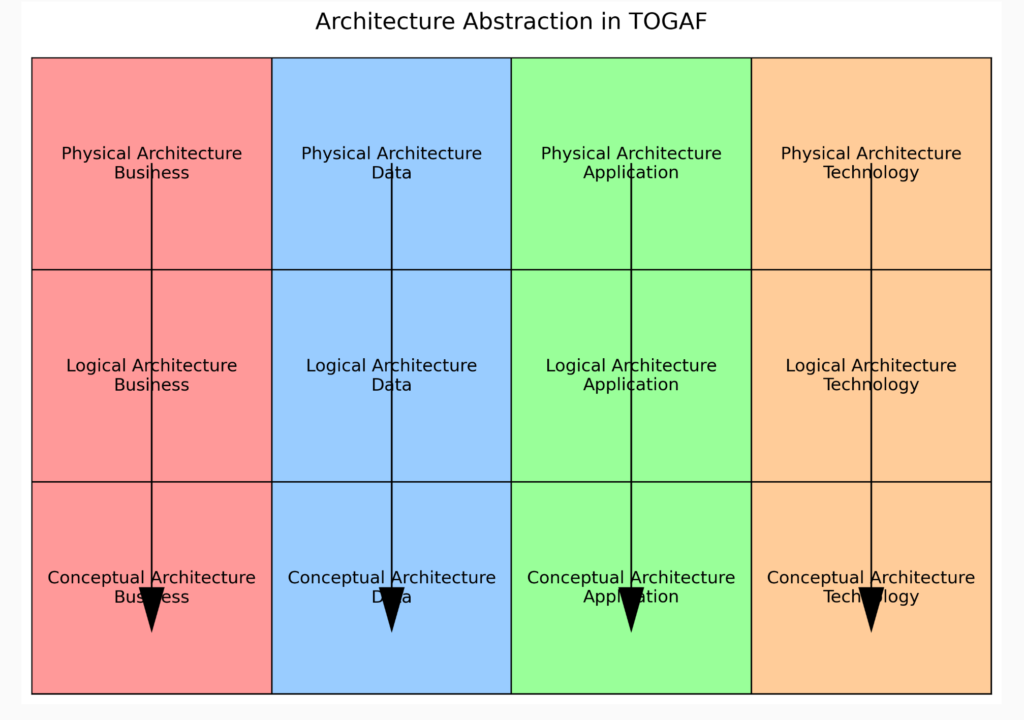Architecture Abstraction in Enterprise Architecture
In the world of enterprise architecture, managing complexity is a constant challenge. TOGAF (The Open Group Architecture Framework) addresses this by introducing the concept of architecture abstraction—a structured way to view systems at different levels of detail. This approach helps stakeholders—from executives to developers—understand and contribute to the architecture in ways that are meaningful to them.
🧱 What is Architecture Abstraction in TOGAF?
TOGAF promotes the use of three levels of abstraction to describe architecture:
- Conceptual Architecture: High-level view of business goals, capabilities, and stakeholder needs.
- Logical Architecture: Technology-agnostic design of systems, data flows, and application interactions.
- Physical Architecture: Concrete implementation details including platforms, tools, and infrastructure.
Each level builds upon the previous one, ensuring that strategic intent is preserved all the way through to implementation.
🧩 Visualizing Architecture Abstraction
Here’s a clear, high-resolution diagram that illustrates how abstraction levels align with the four architecture domains:

This diagram shows how each abstraction layer—Conceptual, Logical, and Physical—spans across the Business, Data, Application, and Technology domains, creating a cohesive and scalable architecture.
✅ Real-World Example 1: Smart City Traffic Management System
🔹 Conceptual Architecture
- Goal: Reduce traffic congestion and improve commuter experience.
- Capabilities: Real-time traffic monitoring, dynamic signal control, commuter alerts.
🔹 Logical Architecture
- Components: Traffic data aggregator, analytics engine, mobile app interface.
- Data Flow: Sensor data → Analytics → Dashboard & Alerts.
🔹 Physical Architecture
- Technologies: IoT sensors, cloud-based analytics (e.g., AWS Lambda), mobile app (iOS/Android), 5G connectivity.
✅ Real-World Example 2: National Digital Health Platform
🔹 Conceptual Architecture
- Goal: Improve healthcare access and patient outcomes.
- Capabilities: Patient records, telemedicine, prescription management.
🔹 Logical Architecture
- Components: EHR system, video consultation module, pharmacy integration.
- Data Flow: Patient data → Doctor interface → Prescription system.
🔹 Physical Architecture
- Technologies: Cloud-hosted EHR (e.g., Azure), secure video conferencing (e.g., WebRTC), encrypted APIs for pharmacies.
🏷 Suggested Tags
- TOGAF
- Enterprise Architecture
- Architecture Abstraction
- Conceptual Architecture
- Logical Architecture
- Physical Architecture
- Smart City
- Digital Health
- IT Strategy
- Architecture Framework
📝 Summary
Architecture abstraction in TOGAF is a foundational concept that enables clarity, collaboration, and scalability. By separating architecture into conceptual, logical, and physical layers, organizations can ensure that strategic intent is preserved from vision to implementation. Whether you’re building a smart city or a national health platform, abstraction is the key to managing complexity and delivering value.